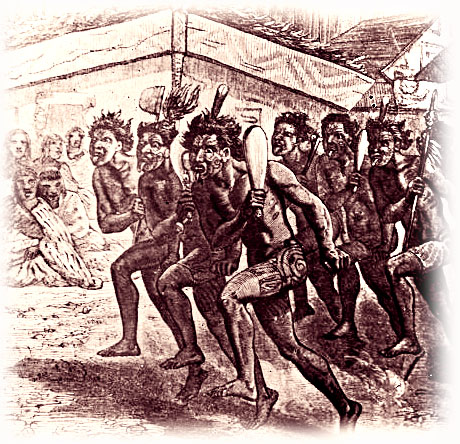|
Haka, poi
and peruperu were used for welcoming guests at meetings.
The peruperu,
a haka perfomed with weapons in hand, was a war dance to demoralise the
enemy forces.
|
"Ere
you go forth to fight, display your legs to your women, young folk,
and old men in what is termed a war-dance. Your women will never
fail to observe the omens of the dance - the correctness of attitudes
or mistakes committed.
When your women are seen by you advancing with distorted faces,
...the rising of Tu-te-ihiihi, of Tu-te-wanawana (the war god),
you then know that your legs will assail the stars in the heavens
and the earth mother below.
But should you commit errors and not deport yourself correctly,
then assuredly you will not see your women dancing and grimacing,
because apprehension has seized them, for from them comes the blood
of the performing men that is to be borne into the fray and poured
forth upon the land. So then you are aware that an error has been
made in your dancing, therefore be cautious."
Nihoniho, 1913
| |
 "Display
your legs to your women..."
"Display
your legs to your women..."
|
"More than any aspect of Maori culture, this
complex dance is an expression of the passion, vigour and identity of
the race. Haka is not merely a pastime of the Maori but was also a custom
of high social importance in the welcoming and entertainment of visitors.
Tribal reputation rose and fell on their ability to perform the haka."
Alan
Armstrong, Maori games and hakas (sic) : instructions,
words, and actions (A.H. & A.W. Reed, 1964)
Te
Hamana Mahuika et al. He Haka Taparahi. Men's ceremonial
dance poetry, Editor, Te Kapunga Dewes. (Vict. Univ. of Wgtn,
Dept of Anthropology, 1972)
Mervyn
McLean, Maori Music (University of Auckland Press 1996)
Tuta
Nihoniho,
(1850-1914) Nga pakanga ki te tai rawhiti 1865-71 : me nga korero
mo uenuku. Narrative of the fighting on the East Coast 1865-71 : with
a monograph on bush fighting (Dominion
Museum, 1913) Reprinted
online
Arthur
S. Thomson. Story of New Zealand : past and present - savage and
civilized (John Murray, London, 1859)
Edward
Tregear, (1846 - 1931) Maori-Polynesian comparative dictionary
(Lyon and Blair, Wellington, 1891) Reprinted
online
Ka
Mate webpage written
by John Archer.
Nov 1999. Revised Jan 2002.
Lost, and reinstalled 13 March 2003. Revised 2006, 2007, 2008
Content divided into eight smaller pages Sept 2008
|